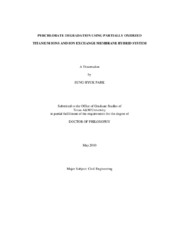| dc.description.abstract | Perchlorate has entered human and environmental food chains and has received a great deal of attention because of its toxicity to humans. In this study, chemical degradation of perchlorate was investigated using partially oxidized titanium ions (Ti2+ and Ti3+) in solutions and as part of an ion exchange membrane reactor system. Aqueous titanium ions (Ti2+ and Ti3+) were applied to remove perchlorate ions and its destructive mechanism, reaction kinetics, and the effect of environmental factors were investigated. Titanium ions were able to degrade perchlorate ions very rapidly with half life less than one hour under conditions of high acid concentrations. A new reactor system with an ion exchange membrane was adapted to apply better the reactions of perchlorate destruction to water treatment practice. A novel treatment method was developed by integrating partially oxidized titanium ions with an ion exchange membrane, and it is named the Titanium and Membrane Hybrid System (TMH System). The results shown in this research demonstrate the feasibility of TMH System for perchlorate reduction. The perchlorate ions were rapidly adsorbed onto the ion exchange membrane and diffused through it, but they were reduced by titanium ions in the degradation zone relatively slowly. To enhance the overall rate of reaction, high concentrations of acid and Ti(III) are needed, but transport of hydrogen ions through the anion permeable membrane was observed and would be greater at higher acid concentrations. The proposed mathematical model predicts the performance and behavior of the TMH system for different physical and chemical conditions. It successfully described adsorption, diffusion and reduction of perchlorate in the system. This model could be used as an important tool for process design and optimization. | en |


